“This post contains affiliate links, and I will be compensated if you make a purchase after clicking on my links.”
Last Updated on April 16, 2024
Great Danes are known to be the “Apollo of Dogs” for a good reason. They are a giant dog breed and their stature can be intimidating not only for other dogs, but also for people.
But despite their intimidating size, they are very affectionate, social, and gentle dogs — hence, the nickname “Gentle Giant”.
And typically, Great Danes experience rapid growth during the first year of their lives. So, as they grow, it is imperative that we monitor their growth, to see if they are growing up healthily and the way they should.
In this article, we’ll discuss what a healthy and typical Great Dane growth chart looks like. We’ll also discuss Great Dane’s growth stages, what factors affect a Great Dane’s growth, and everything in between!
The Generally Healthy Size and Weight For The Great Dane Breed

Generally, Great Dane puppies grow rapidly during their first year. And if you’re wondering just how fast this growth is, the Great Dane Club of America compares their first year growth to that of a human child growing in 14 years.
And just like any other dog, they can experience rapid growth spurts. Some puppies experience this as early as 3 to 5 months old, and some can experience it later in their first year, at 11 months old.
How Much Does A Great Dane Puppy Weigh At 7-8 Weeks?
Generally, a 7 or 8-week-old Great Dane puppy should weigh between 18-26 pounds. But keep in mind that male Great Danes are on the higher end and can weigh more than female Great Danes.
It is important that you monitor your Great Dane puppy’s growth. While it is true that they grow rapidly during their first year, but if they grow TOO quickly, they can suffer later in their adult years and be more prone to health issues such as hip dysplasia.
To make sure a Great Dane puppy grows healthily, ensure that they are getting proper nutrition. Typically, an 8-week-old Great Dane puppy needs to eat around 2 to 4 cups of dog food a day.
If you think your Great Dane puppy is too small or too big for their age, you might also want to check their lineage.
For example, European Great Danes are much bigger and heavier than their American counterpart, so that might be a contributing factor to why your Great Dane is “too big”.
When Does A Great Dane Stop Growing?
Each Great Dane is different. However, generally speaking, they stop growing and are considered “fully grown” between 1.5 years and 2 years of age.
However, after reaching their full height, they are still likely to continue to add bulk and muscle to fill out their frame until they are about 3 years old.
So, you can expect that a 4-year-old Great Dane dog will significantly look different from his 2-year old self.
Ideally, a fully grown male Great Dane grows between 30 to 36 inches and can weight anywhere between 100 to 200 lbs. Meanwhile, female Great Danes can be slightly smaller and can grow from 29 to 33 inches and can weigh from 110 to 140 lbs.
Great Dane Growth Chart:
Note that every Great Dane is different and this chart is a general guideline. So, you shouldn’t worry too much if your Great Dane doesn’t follow these exact numbers.
However, if you see huge differences between these numbers and your Great Dane’s actual height and weight, do not hesitate to discuss this with your dog’s vet.
So, to know more about a Great Dane’s growth throughout their life, here is a typical Great Dane growth chart. In this chart, you’ll see that during the first year of their lives, both male and female Danes have similar weight and height.
However, once they reach adulthood, the weight and height of male and female Danes start to differ — males are a little taller and are therefore much heavier.
| Age | Weight (Pounds) | Height (Inches) | Weight ( Kgs) | Height (cm) |
| At Birth | 1 – 2 | NA | 0.45 – 0.90 | NA |
| 1 Week | 2 – 3 | NA | 0.90 – 1.36 | NA |
| 2 Weeks | 3 – 5 | NA | 1.3 – 2.3 | NA |
| 3 Weeks | 4 – 7 | NA | 1.8 – 3.2 | NA |
| 4 Weeks | 5 – 8 | NA | 2.3 – 3.6 | NA |
| 6 Weeks | 10 – 20 | NA | 4.5- 9.0 | NA |
| 2 Months | 18 – 26 | 13 – 18 | 8.2 – 11.8 | 33.0 – 45.7 |
| 3 Months | 30 – 45 | 17 – 23 | 13.6 -20.41 | 43.2 – 58.4 |
| 4 Months | 45 – 65 | 21 – 26 | 20.4 – 29.5 | 53.3 – 66.0 |
| 5 Months | 60 – 85 | 23 – 30 | 27.2 – 38.5 | 58.4 – 76.2 |
| 6 Months | 70 – 105 | 26 – 33 | 31.7 – 47.6 | 66.0 – 83.8 |
| 7 Months | 75 – 110 | 27 – 34 | 34.0 – 49.9 | 68.6 – 86.36 |
| 8 Months | 80 – 120 | 27 – 35 | 36.3 – 54.3 | 68.6 – 88.9 |
| 9 Months | 85 – 125 | 28 – 35 | 38.5 – 56.7 | 71.1 – 88.9 |
| One year | 90 – 140 | 29 – 36 | 40.8 – 63.50 | 73.6 – 91.4 |
| ADULT | WEIGHT (lbs) | Height (inches) | WEIGHT (kg) | Height (cm) |
| Males | 135 – 170 | 33 – 36 | 61.2 – 77.1 | 83.8 – 91.4 |
| Females | 110 – 145 | 30 – 34 | 49.9 – 65.7 | 76.2 – 86.4 |
Here is a simplified version of the abovementioned Great Dane growth chart:
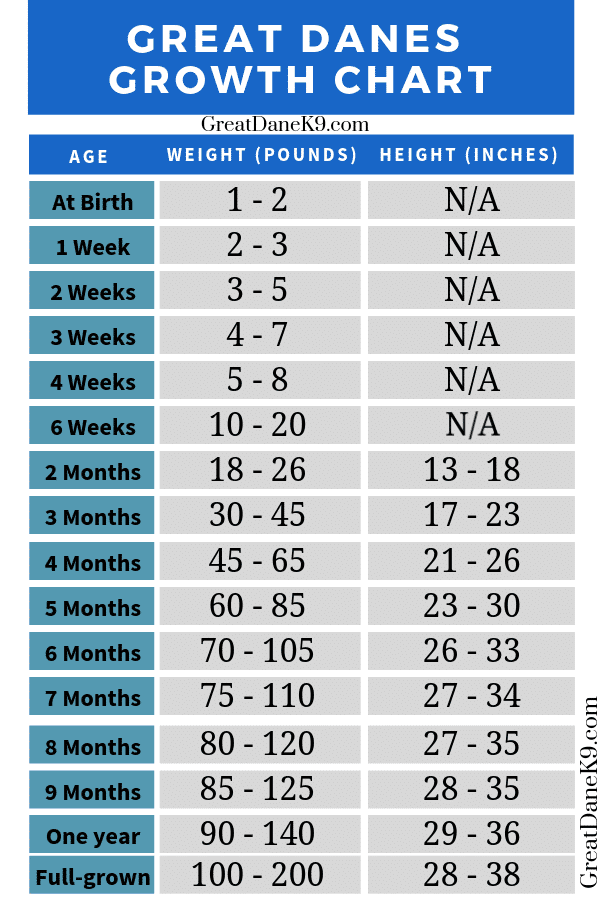
Great Dane Weight Chart
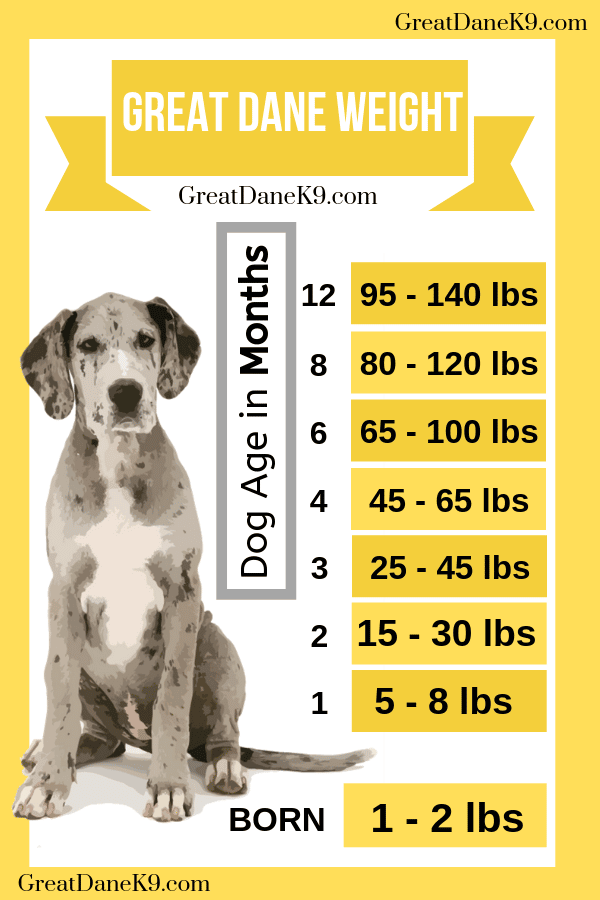
Great Dane Height Chart
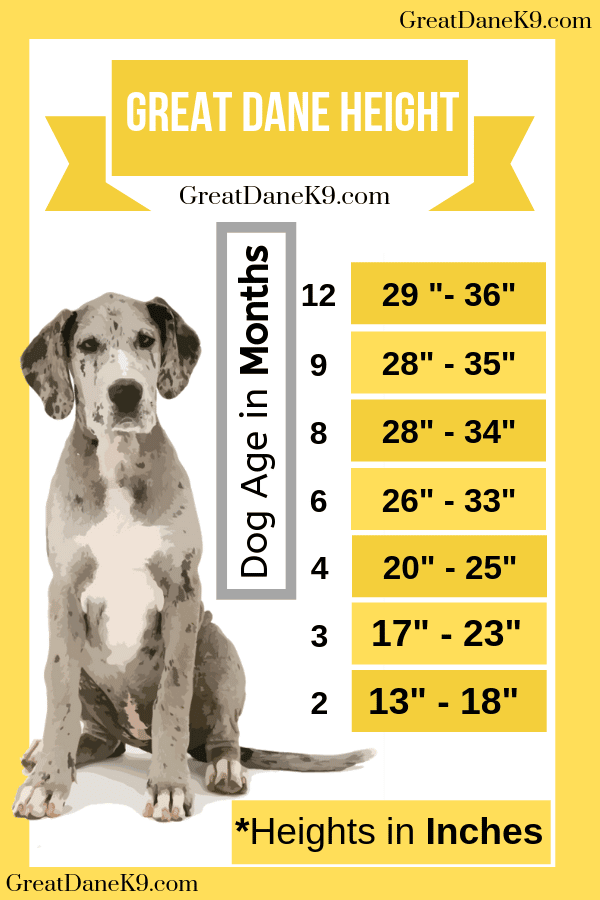
Great Dane Growth Stages
A Great Dane’s growth from a puppy to a full-grown adult dog can be easily seen in the difference in its stature. You’ll be able to see a healthy Great Dane’s growth in the chart below:
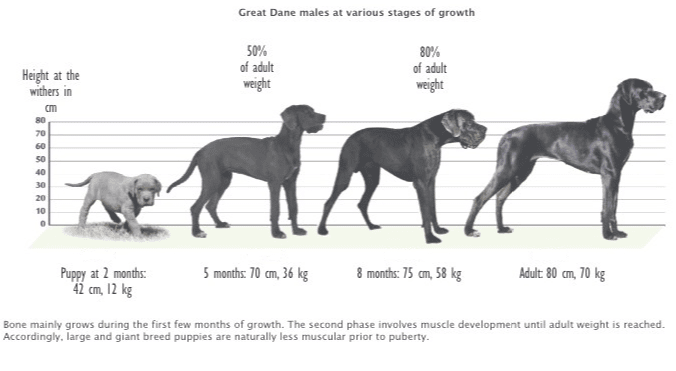
Stage 1 Of Great Dane Growth
The first stage of a Great Dane’s growth is from the moment they’re born as puppies up to 2 months old. During this stage in their life, the puppy starts less interactive. This is because they are both blind and deaf the moment they are born and they are only starting to develop most of their senses.
During this stage, their main source of food and nutrition is their mother’s milk. However, as they turn 2 months old, you should be able to separate the puppy from their mother and be able to give them about three meals a day.
This is also the stage in their life where you start training and socializing them. This stage is crucial to building their character so they can grow up to be well-behaved dogs.
Stage 2 Of Great Dane Growth
By the time they reach the second stage of their growth, a Great Dane puppy is 5 months old and has gained about half (50%) of their adult weight.
During this time, you’ll see just how big your Great Dane puppy is getting! And having a puppy with a playful nature weighing between 30kg to 50kg can be difficult to handle.
So, it’s important to continue training during this stage in life and be able to establish their everyday routine.
Stage 3 Of Great Dane Growth
Stage 3 of a Great Dane’s growth is where your dog has gained almost all of his adult weight at 80% at 8 months old. During this stage of their life, they’re well on their way to adulthood. And as compared to the second stage, they are now more matured and well-behaved.
So, by this time, they should’ve learned all the basic training, have an established everyday routine, and have a close relationship with you.
Stage 4 Of Great Dane Growth
This is the fourth and final stage of a Great Dane’s growth. During this time, they should’ve successfully settled down with their life at home and are a lot more behaved and socialized.
Since they’ve reached the end of their growth, this stage in life is also when Great Danes begin to bulk up with muscles to fill in their frame. This will continued until they’re about 3 years old.
Great Dane Growth In Pictures
Here are photos that show the growth process of a Great Dane dog from 2 weeks to 10 months:

Factors That Impact Great Dane Growth
A Great Dane’s growth can also be affected by some factors. Below, we have enumerated these factors that have the ability to either boost or restrict a Great Dane’s development:
1. Genetics
The first factor that impacts a Great Dane’s growth and development is its genetics. From their height, weight, and even the rate at which the Great Dane grows — their bloodline is a huge contributing factor to their overall growth.
Sometimes, looking at your Great Dane’s parents can give you a general idea of how heavy and tall your dog will grow in to. However, this may not be very accurate as the parents may carry genes that can result to smaller offspring.
Furthermore, due to genetics, there are Great Danes that do not grow steadily during the first 6 months of their life.
2. Spaying or Neutering
For Great Danes, spaying or neutering them at the right time can also play a significant role in their growth. This is especially true for male Great Danes, because they generally grow taller after being neutered.
Male Great Danes should be neutered once they’re fully grown, around 12 to 15 months old. Meanwhile, female Great Danes should be spayed after their first heat cycle. This is because their hormones positively contribute to their overall growth.
Furthermore, spaying and neutering doesn’t only positively contribute to a Great Dane’s growth, but to their chances at a longer and healthier life.
3. Feeding Habits
There is a very common misconception that a Great Dane puppy would grow faster if you feed it more food. However, this is not true. Overfeeding a Great Dane puppy will do more harm than good in the long run.
However, Great Dane puppies have to eat more than Great Dane adults in order to sustain the massive growth they undergo during the first year of their life.
In order for your Great Dane puppy to grow healthily, you have to feed it during the right time, with the correct amount of food. Furthermore, Great Dane puppies should not be given adult dog food.
4. Growth Spurt
Just like all other dogs, your Great Dane will go through rapid growth spurts, which may cause some mild pain. The age of Great Dane growth spurt really depends on each dog.
During a growth spurt, your Great Dane can grow 2 inches in a week, as compared to some days where they only grow ¼ inch in 10 days.
Conclusion
There is no doubt that Great Danes are majestic dogs thanks to their intimidating size. Which makes it all the more important to be knowledgeable about their growth and development.
Doing your research and understanding your Great Dane’s growth, especially during the first year of their life, is crucial to ensure that they’ll be able to live a long, happy, and healthy life.
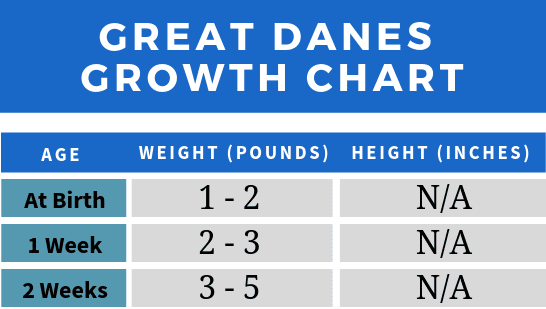
Thank you for answering all my questions.
I had a dog dropped off in my road on October 6, 2020, she was skin and bones. Starved to death. When I picked her up It felt like her ribs were going to break. She weighed 13 pounds. It is now November 4, we have had her almost a month, she weighs 30 pounds. The vet put her on an antibiotic. She is 4 months old. She is a Great Dane/mix, it seems as though she never gets full. How much and what should I be feeding her?
You can feed the GD according to the chart included in the article. Moreover, if you are feeding according to the chart right now, yet the GD “seems as though she never gets full” is a healthy sign that the GD pup is doing good overall and is loving the food it is getting from you. Keep up the good work Kelli Johnson!
Wow, I wonder if we are neighbors.. I have the same case, dates and all!
She is almost the same age as my male he is 8 months now Ca and he is fed 8 cups of Nutra brand adult food per day. 2-2/3 cups three times per day. At 10 months he will get 10 cups of that brand per day
My dane can eat over 8 cups in a 15 min setting. The vet said that they eat all that is in front of them. I reduced the ammount and fed 2 times a day. If you have runny or loose stool cut back and try 3 times a day
Vet said if you moniter thos pup will be around 6 to 7 cups a day every dane is different
how are european great danes different? do you have any articles on that?
European Great Danes tend to grow bulkier as compared to American Great Danes. Find the detail on European Great Danes here,Appearance of European vs American Great Danes
Why is my Great Dane so big ?
164 lbs and 41 inch’s to shoulder
He’s 9 months old
My last one was well over 200lbs all muscle and 44 inches tall at the shoulder. The biggest dane my vet ever seen. Unfortunately because he was so big he developed an enlarged heart and passed away a day after his 7th bday 🙁 his grandfather was European and bred with a Canadian. He was the only one to get that big. Sisters were 140s, brothers, 160s
Great content. it was very helpful
Very nice article